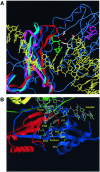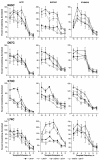Nonnucleoside inhibitor binding affects the interactions of the fingers subdomain of human immunodeficiency virus type 1 reverse transcriptase with DNA
- PMID: 15016861
- PMCID: PMC371094
- DOI: 10.1128/jvi.78.7.3387-3397.2004
Nonnucleoside inhibitor binding affects the interactions of the fingers subdomain of human immunodeficiency virus type 1 reverse transcriptase with DNA
Abstract
Site-directed photoaffinity cross-linking experiments were performed by using human immunodeficiency virus type 1 (HIV-1) reverse transcriptase (RT) mutants with unique cysteine residues at several positions (i.e., positions 65, 67, 70, and 74) in the fingers subdomain of the p66 subunit. Since neither the introduction of the unique cysteine residues into the fingers nor the modification of the SH groups of these residues with photoaffinity cross-linking reagents caused a significant decrease in the enzymatic activities of RT, we were able to use this system to measure distances between specific positions in the fingers domain of RT and double-stranded DNA. HIV-1 RT is quite flexible. There are conformational changes associated with binding of the normal substrates and nonnucleoside RT inhibitors (NNRTIs). Cross-linking was used to monitor intramolecular movements associated with binding of an NNRTI either in the presence or in the absence of an incoming deoxynucleoside triphosphate (dNTP). Binding an incoming dNTP at the polymerase active site decreased the efficiency of cross-linking but caused only modest changes in the preferred positions of cross-linking. This finding suggests that the fingers of p66 are closer to an extended template in the "open" configuration of the enzyme with the fingers away from the active site than in the closed configuration with the fingers in direct contact with the incoming dNTP. NNRTI binding caused increased cross-linking in experiments with diazirine reagents (especially with a diazirine reagent with a longer linker) and a moderate shift in the preferred sites of interaction with the template. Cross-linking occurred closer to the polymerase active site for RTs modified at positions 70 and 74. The effects of NNRTI binding were more pronounced in the absence of a bound dNTP; pretreatment of HIV-1 RT with an NNRTI reduced the effect of dNTP binding. These observations can be explained if the binding of NNRTI causes a decrease in the flexibility in the fingers subdomain of RT-NNRTI complex and a decrease in the distance from the fingers to the template extension.
Figures





Similar articles
-
Cross-linking of the fingers subdomain of human immunodeficiency virus type 1 reverse transcriptase to template-primer.J Virol. 2001 Oct;75(19):9435-45. doi: 10.1128/JVI.75.19.9435-9445.2001. J Virol. 2001. PMID: 11533206 Free PMC article.
-
The HIV-1 p66 homodimeric RT exhibits different conformations in the binding-competent and -incompetent NNRTI site.Proteins. 2017 Dec;85(12):2191-2197. doi: 10.1002/prot.25383. Epub 2017 Sep 26. Proteins. 2017. PMID: 28905420 Free PMC article.
-
Nucleoside analog resistance caused by insertions in the fingers of human immunodeficiency virus type 1 reverse transcriptase involves ATP-mediated excision.J Virol. 2002 Sep;76(18):9143-51. doi: 10.1128/jvi.76.18.9143-9151.2002. J Virol. 2002. PMID: 12186898 Free PMC article.
-
Conformational changes in HIV-1 reverse transcriptase induced by nonnucleoside reverse transcriptase inhibitor binding.Curr HIV Res. 2004 Oct;2(4):323-32. doi: 10.2174/1570162043351093. Curr HIV Res. 2004. PMID: 15544453 Free PMC article. Review.
-
HIV-1 reverse transcriptase connection subdomain mutations involved in resistance to approved non-nucleoside inhibitors.Antiviral Res. 2011 Nov;92(2):139-49. doi: 10.1016/j.antiviral.2011.08.020. Epub 2011 Aug 28. Antiviral Res. 2011. PMID: 21896288 Review.
Cited by
-
Liver Fibrosis during Antiretroviral Treatment in HIV-Infected Individuals. Truth or Tale?Cells. 2021 May 15;10(5):1212. doi: 10.3390/cells10051212. Cells. 2021. PMID: 34063534 Free PMC article. Review.
-
HIV-1 reverse transcriptase complex with DNA and nevirapine reveals non-nucleoside inhibition mechanism.Nat Struct Mol Biol. 2012 Jan 22;19(2):253-9. doi: 10.1038/nsmb.2223. Nat Struct Mol Biol. 2012. PMID: 22266819 Free PMC article.
-
Minimalist model for force-dependent DNA replication.Biophys J. 2012 Feb 22;102(4):810-8. doi: 10.1016/j.bpj.2012.01.020. Epub 2012 Feb 21. Biophys J. 2012. PMID: 22385852 Free PMC article.
-
Localization of ASV integrase-DNA contacts by site-directed crosslinking and their structural analysis.PLoS One. 2011;6(12):e27751. doi: 10.1371/journal.pone.0027751. Epub 2011 Dec 1. PLoS One. 2011. PMID: 22145019 Free PMC article.
-
Reverse Transcriptase and Cellular Factors: Regulators of HIV-1 Reverse Transcription.Viruses. 2009 Dec;1(3):873-94. doi: 10.3390/v1030873. Epub 2009 Nov 10. Viruses. 2009. PMID: 21994574 Free PMC article.
References
-
- Althaus, I. W., J. J. Chou, A. J. Gonzales, M. R. Deibel, K. C. Chou, F. J. Kezdy, D. L. Romero, R. C. Thomas, P. A. Aristoff, W. G. Tarpley, et al. 1994. Kinetic studies with the non-nucleoside human immunodeficiency virus type-1 reverse transcriptase inhibitor U-90152E. Biochem. Pharmacol. 47:2017-2028. - PubMed
-
- Benn, S., R. Rutledge, T. Folks, J. Gold, L. Baker, J. McCormick, P. Feorino, P. Piot, T. Quinn, and M. Martin. 1985. Genomic heterogeneity of AIDS retroviral isolates from North America and Zaire. Science 230:949-951. - PubMed
-
- Boyer, P. L., C. Tantillo, A. Jacobo-Molina, R. G. Nanni, J. Ding, E. Arnold, and S. H. Hughes. 1994. Sensitivity of wild-type human immunodeficiency virus type 1 reverse transcriptase to dideoxynucleotides depends on template length; the sensitivity of drug-resistant mutants does not. Proc. Natl. Acad. Sci. USA 91:4882-4886. - PMC - PubMed
Publication types
MeSH terms
Substances
Grants and funding
LinkOut - more resources
Full Text Sources

